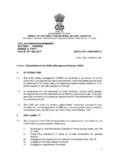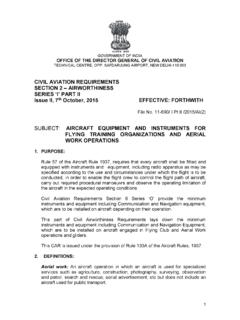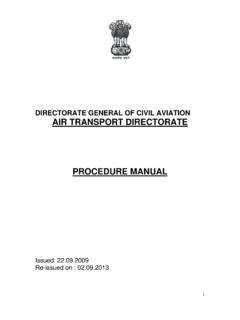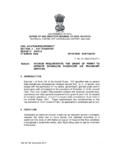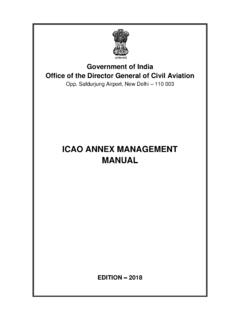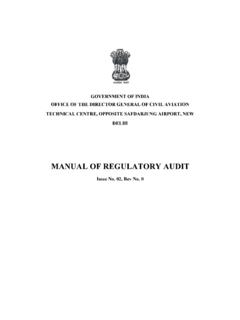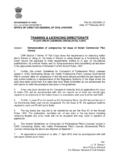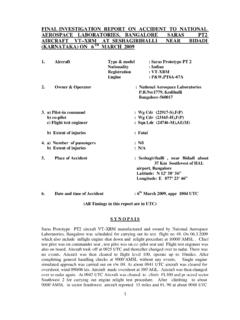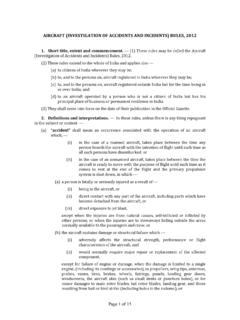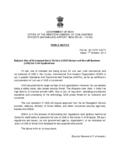Transcription of GOVERNMENT OF INDIA SECTION 8 - AIRCRAFT …
1 Rev 2, 5th July 2017 1 GOVERNMENT OF INDIA OFFICE OF THE DIRECTOR GENERAL OF CIVIL AVIATION TECHNICAL CENTRE, OPP SAFDURJUNG AIRPORT, NEW DELHI CIVIL AVIATION requirements SECTION 8 - AIRCRAFT OPERATIONS SERIES 'S' PART I ISSUE II, 04TH SEPTEMBER 2014 Revision 1 Effective: 01st JANUARY 2017 File No: AV. 22024/16/2013-FSD SUBJECT: requirements FOR EXTENDED DIVERSION TIME OPERATIONS (EDTO) FOR COMMERCIAL AIR TRANSPORT. 1. INTRODUCTION: The purpose of initial ETOPS regulations were to provide very high level of safety while facilitating the use of twin engines on routes, which were previously restricted to three or four engine aeroplanes. ETOPS has now evolved to EDTO (Extended Diversion Time Operations) to encompass two or more engine aeroplanes and the intent of the current regulation is to avoid a diversion and if it occurs, to ensure that the diversion is safe.
2 EDTO may be referred as ETOPS in some documents (AFM etc). This Civil Aviation Requirement is issued under the provision of Rule 29C and 133A of the AIRCRAFT Rules 1937 and lays down requirements for obtaining airworthiness and operational approval for EDTO. 2. APPLICABILITY: This CAR is applicable to operators engaged in Commercial Air Transport Operations beyond the threshold time established by DGCA for EDTO and lays down the minimum requirements for turbine aeroplanes transiting oceanic areas or routes over land, registered in INDIA , and engaged in EDTO. Operators shall not operate an aeroplane with two or more engines or an aeroplane of AUW more than 5700 kg beyond the threshold time unless approved by DGCA for EDTO. CIVIL AVIATION requirements SECTION 8 SERIES S PART I 4TH SEPTEMBER 2014 Rev 2, 5th July 2017 2 To be eligible for EDTO the specified airframe/engine combination should have been certificated to the Airworthiness Standards of Transport Category aeroplanes by FAA of USA or EASA or by any other regulatory authority acceptable to DGCA 3.
3 DEFINITIONS: Alternate Aerodrome. An aerodrome to which an AIRCRAFT may proceed when it becomes either impossible or inadvisable to proceed to or to land at the aerodrome of intended landing where the necessary services and facilities are available, where AIRCRAFT performance requirements can be met and which is operational at the expected time of use. Alternate aerodromes include the following: Take-off alternate. An alternate aerodrome at which an AIRCRAFT would be able to land should this become necessary shortly after take-off and it is not possible to use the aerodrome of departure. En-route alternate. An alternate aerodrome at which an AIRCRAFT would be able to land in the event that a diversion becomes necessary while en route. Destination alternate. An alternate aerodrome at which an AIRCRAFT would be able to land should it become either impossible or inadvisable to land at the aerodrome of intended landing.
4 Extended diversion time operations (EDTO). Any operation by an aeroplane with two or more turbine engines where the diversion time to an en-route alternate aerodrome is greater than the threshold time established by the DGCA. EDTO Entry Point. The first point on the route of an EDTO flight; determined using a one-engine inoperative cruise speed under standard conditions in still air that is more than the threshold from an enroute alternate airport for airplanes with two engines and more than two engines. 3,4 EDTO critical fuel. The fuel quantity necessary to fly to an en-route alternate aerodrome considering, at the most critical point on the route, the most limiting system failure. Note: Attachment D to ICAO Annex 6 Part I contains guidance on EDTO critical fuel scenarios. EDTO-significant system.
5 An aeroplane system whose failure or degradation could adversely affect the safety particular to an EDTO flight, or whose continued functioning is specifically important to the safe flight and landing of an aeroplane during an EDTO diversion. CIVIL AVIATION requirements SECTION 8 SERIES S PART I 4TH SEPTEMBER 2014 Rev 2, 5th July 2017 Isolated aerodrome. A destination aerodrome for which there is no destination alternate aerodrome suitable for a given aeroplane type. Maximum diversion time. Maximum allowable range, expressed in time, from a point on a route to an en-route alternate aerodrome. Point of no return. The last possible geographic point at which an aeroplane can proceed to the destination aerodrome as well as to an available en route alternate aerodrome for a given flight.
6 Threshold time. The range, expressed in time, established by the State of the Operator to an en-route alternate aerodrome, whereby any time beyond requires an EDTO approval from the State of the Operator. Note 1: The threshold time for EDTO established by DGCA is 60 minutes for two engine aeroplanes with maximum passenger seating capacity of more than 19 passengers and maximum AUW more than 45360 kgs and scheduled operators with two engine aeroplanes irrespective of AUW and passenger capacity. Note 2: The threshold time for EDTO established by DGCA is 90 minutes for Non-scheduled operators (NSOPs) operating two engine aeroplanes with maximum passenger seating capacity of 19 or less passengers and maximum AUW less than 45360 kgs. Note 3: The threshold time for EDTO established by DGCA is 120 minutes for more than two engine aeroplanes.
7 Auxiliary Power Unit (APU). A gas turbine engine intended for use as a power source for driving generators, hydraulic pumps and other aeroplane accessories, equipment and/or to provide compressed air for aeroplane pneumatic system. In - Flight Shutdown (IFSD). When an engine ceases to function in flight and is shutdown, whether self-induced, crew initiated or caused by some other external influence ( IFSD for all cases; for example due to flameout, internal failure, crew initiated shutoff, foreign object ingestion, icing, inability to obtain and/or control desired thrust etc.). Propulsion System. A system consisting of power unit and all other equipment utilized to provide those functions necessary to sustain, monitor and control the power/thrust output of any one-power unit following installation on the airframe.
8 EDTO Configuration, Maintenance and Procedures (CMP) particular aeroplane configuration minimum requirements including any special inspection, hardware life limits, master minimum equipment list constraints and maintenance practices found necessary to establish the suitability of an airframe engine combination for an EDTO. CIVIL AVIATION requirements SECTION 8 SERIES S PART I 4TH SEPTEMBER 2014 Rev 2, 5th July 2017 44. GENERAL requirements FOR EXTENDED DIVERSION TIME OPERATIONS (EDTO) Unless the operation has been specifically approved by DGCA an aeroplane with two or more turbine engines shall not, be operated on a route where the diversion time from any point on the route, calculated in ISA and still air conditions at the one-engine inoperative cruise speed for aeroplanes with two turbine engines and at the all-engine operating cruise speed for aeroplanes with more than two turbine engines, to an en-route alternate aerodrome exceeds a threshold time established for such operations by the DGCA Note1: When the diversion time exceeds the threshold time, the operation is considered to be an extended diversion time operation (EDTO).
9 Note2: For the purpose of EDTO, the take-off and/or destination aerodromes may be considered en-route alternate aerodromes. The maximum diversion time, for an operator of a particular aeroplane type engaged in extended diversion time operations shall be approved by DGCA. Note. Guidance on the conditions to be used when converting diversion times to distances are contained in Attachment D to ICAO Annex 6 Part I. When approving the appropriate maximum diversion time for an operator for a particular aeroplane type engaged in extended diversion time operations, DGCA shall ensure that: (a) for all aeroplanes: the most limiting EDTO significant system time limitation, if any, indicated in the Aeroplane Flight Manual (directly or by reference) and relevant to that particular operation is not exceeded; and (b) for aeroplanes with two turbine engines: the aeroplane is EDTO certified.
10 Notwithstanding the provisions in Para above, DGCA may, based on the results of a specific safety risk assessment conducted by the operator which demonstrates how an equivalent level of safety will be maintained, approve operations beyond the time limits of the most time-limited system. The specific safety risk assessment shall include at least the (a) capabilities of the operator; (b) overall reliability of the aeroplane; (c) reliability of each time limited system; (d) relevant information from the aeroplane manufacturer; and (e) specific mitigation measures For aeroplanes engaged in EDTO, the additional fuel required by CAR SECTION 8 Series O Part II Para f) 2) shall include the fuel necessary to comply with the EDTO critical fuel scenario as established in this CAR. CIVIL AVIATION requirements SECTION 8 SERIES S PART I 4TH SEPTEMBER 2014 Rev 2, 5th July 2017 5 A flight shall not proceed beyond the threshold time in accordance with Para above unless the identified en-route alternate aerodromes have been re-evaluated for availability and the most up to date information indicates that, during the estimated time of use, conditions at those aerodromes will be at or above the operator s established aerodrome operating minima for the operation.
